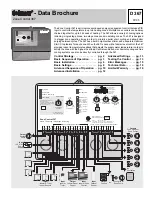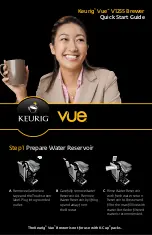
14
Step 3 - The control tests relays 3 and 4 using the procedure described in Step 2.
Step 4 - If the DIP switches are set to Zone 1 Heating and Zone 2 Heating, the control tests relays 1 and 2 using the procedure
described in Step 2.
-
If the DIP switch is set to
Zone 2 Ventilating or its is set to Zone 2 Heating and an RTU is connected to RTU 2, the control
turns on relay
2 for 10 seconds.
-
If the DIP switch is set to
Zone 1 Cooling or an RTU is connected to RTU 1 the
control turns on relay
1 for 10 seconds.
Step 5 - After the test sequence is complete, the Test light begins flashing and the control enters a fast mode of operation. During
this time, the control is more responsive to setting adjustments. If the dial on an RTU is turned up, the on time of the zone
relay increases immediately. After fifteen minutes, the control reverts back to normal operating conditions and the on times
are based on the average temperature during the previous 15 minute cycle.
Manual Test
While the control is in the fast mode of operation and the
Test light is flashing, check that
each RTU operates the proper zone valve or zone pump. Turn up the
RTU dial to turn the
zone on, turn the dial down to turn the zone off. If an Indoor Sensor is used, a cold spray
to the sensor will turn the zone on.
Indicator Lights “On”
Power
• 120 V (ac) power is applied to the control and the control
is energized.
Heat Required
• The 367 is sending a heat required signal to a tekmar reset control. At least one of the heating zones
requires heat.
System Pump
• The relay contact between
System Pmp—System Pmp (1 and 2) is closed and the System Pump should
be turned on.
Zone 1 / Lo Stage /
• The relay contact between
Com 1-2— 1 (19 and 20) is closed and the device connected to this relay
Open / Cooling
should be turned on.
Zone 2 / Hi Stage /
• The relay contact between
Com 1-2— 2 (19 and 21) is closed and the device connected to this relay
Close / Ventilation
should be turned on.
Zone 3 / Lo Stage /
• The relay contact between
Com 3-4— 3 (22 and 23) is closed and the device connected to this relay
Open
should be turned on.
Zone 4 / Hi Stage /
• The relay contact between
Com 3-4— 4 (22 and 24) is closed and the device connected to this relay
Close
should be turned on.
Zone 5 / Lo Stage /
• The relay contact between
Com 5-6— 5 (25 and 26) is closed and the device connected to this relay
Open
should be turned on.
Zone 6 / Hi Stage /
• The relay contact between
Com 5-6— 6 (25 and 27) is closed and the device connected to this relay
Close
should be turned on.
Test
• The control is proceeding through the programmed test sequence.
Occupied
• The control is in Occupied mode.
UnOccupied
• The control is in UnOccupied (Night Setback) mode.
Optimum Start / Stop
• The control is warming the building up during the final stages of the UnOccupied period, or the heating
system is turned off during the final stages of the Occupied period.
Timer Active
• The timer is set to enter the UnOccupied mode every 24 hours at the time of day the
Start button was
pressed.
STEP EIGHT
TROUBLESHOOTING
As in any troubleshooting procedure, it is important to isolate a problem as much as possible before proceeding. The Error Messages
and
Test button greatly simplify troubleshooting of the 367. When the control is flashing an error message, identify the fault from the
look-up table on page 15 and follow standard testing procedures to confirm the problem. If you suspect a wiring fault, return to steps
three, four and five, and carefully check all external wiring and wiring connections.
Sensor and Internal Faults
• If an Outdoor Sensor fault occurs, the 367 operates as if an Outdoor Sensor is not connected. An error message is displayed.
• If an RTU / Indoor Sensor fault occurs or an external Zone Control input
Zo - in short circuits, the 367 operates as if that RTU or
Zone Control is not connected. An error message is displayed.
• If an internal control fault occurs, the 367 displays an error message. Press the
Test button to clear the error message. If the error
message remains, the control must be returned for repair.
Adjusting RTU settings provides an immediate
response for the first 15 minutes only.
70
M
Test


































